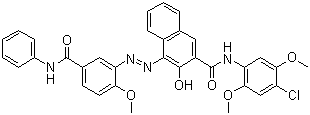Pigment Rouge 146
| Nom du produit | PIGMENT RED 146 |
| Synonymes | C.I.Pigment Red 146; C.I.PR146; PR146; P.R.146 |
| CI | 12485 |
| N ° CAS. | 52-68-2 |
| EINECS | 226-103-2 |
| Masse moléculaire | 611.04 |
| Formule moléculaire | C33H27ClN4O6 |
| Densité | 1,33 g/cm3 |
| Couleur | Poudre rouge |
![]()
Formule de structure moléculaire :

Fastness Properties of Pigment Red 146:
| Solidité à la lumière | 5 |
| Résistance à la chaleur (℃) | 180 |
| Résistance à l'eau | 5 |
| Résistance à l'huile | 5 |
| Résistance aux acides | 4 |
| Résistance aux alcalis | 4 |
| Résistance à l'alcool | 4-5 |
Application principale : Encre à base d'eau, Encre offset, Encre à base de solvant, Plastique, Peinture, Impression textile
Nous avons différentes qualités et propriétés de pigments pour répondre aux différents besoins des clients, veuillez spécifier votre application et vos exigences afin que nous puissions vous recommander en conséquence. Courriel : sy@sypigment.com
Product Description of Pigment Red 146:
Pigment Red 146 is slightly yellowish than pigment red 57:1. The specific surface area of Permanent Carmine FBB 02 is 36m2/g. It is mainly used for printing inks and coatings. The solvent resistance and sterilization treatment of printed samples are better than pigment red 57:1, heat stability 200℃/10min, 20℃ higher than pigment red 57:1, light resistance grade 5, better than pigment red 57:1 high 0.5-1 level; lightfastness level 7 (1/1SD) on fabric printing; also used in latex paint and architectural coatings, combined with molybdenum chrome orange to create a non-transparent red color; hard PVC coloring lightfastness level 8 Grade; brown with pigment yellow 83 and carbon black, used for wood coloring.
Pigment Red 146 is a naphthol carmine dye. This product's density is 1.5 g/cm3 and its pH value is 7.0. Its molecular weight is 611.04. Pigment Red 146 is a semi-transparent, slightly bluish monoazo red pigment. It is recommended for general industrial coatings, textile printing, offset inks, water-based inks, UV inks, and is especially recommended for solvent-based inks.
TDS (Pigment Red 146) MSDS (Pigment Red 146)Synonymes
- Pigment Rouge 146
- 5280-68-2
- N-(4-chloro-2,5-dimethoxyphenyl)-3-hydroxy-4-[[2-methoxy-5-(phenylcarbamoyl)phenyl]diazenyl]naphthalene-2-carboxamide
- (4Z)-N-(4-chloro-2,5-dimethoxyphenyl)-4-[[2-methoxy-5-(phenylcarbamoyl)phenyl]hydrazinylidene]-3-oxonaphthalene-2-carboxamide
- N-(4-Chloro-2,5-dimethoxyphenyl)-3-hydroxy-4-((2-methoxy-5-((phenylamino)carbonyl)phenyl)azo)naphthalene-2-carboxamide
- PigmentRed146
- 2-Naphthalenecarboxamide, N-(4-chloro-2,5-dimethoxyphenyl)-3-hydroxy-4-((2-methoxy-5-((phenylamino)carbonyl)phenyl)azo)-
- 2-Naphthalenecarboxamide, N-(4-chloro-2,5-dimethoxyphenyl)-3-hydroxy-4-[[2-methoxy-5-[(phenylamino)carbonyl]phenyl]azo]-
- Pigment Red 146, tech.
- C33H27ClN4O6
- DTXSID3063754
- SCHEMBL12954942
- SCHEMBL14497174
- EINECS 226-103-2
- MFCD00071995
- AKOS037647858
- ZINC100049553
- P.R.146
- 2-Naphthalenecarboxamide,N-(4-chloro-2,5-dimethoxyphenyl)-3-hydroxy-4-[[2-methoxy-5-[(phenylamino)carbonyl]phenyl]azo]-
- AS-75061
- V0990
- D93848
- EC 226-103-2
- 280P682
- W-110020
- 2-Naphthalenecarboxamide, N-(4-chloro-2,5-dimethoxyphenyl)-3-hydroxy-4-(2-(2-methoxy-5-((phenylamino)carbonyl)phenyl)diazenyl)-
- N-(4-chloro-2,5-dimethoxyphenyl)-3-hydroxy-4-[(1E)-2-[2-methoxy-5-(phenylcarbamoyl)phenyl]diazen-1-yl]naphthalene-2-carboxamide
- N-(4-Chloro-2,5-dimethoxyphenyl)-3-hydroxy-4-[[2-methoxy-5-[(phenylamino)carbonyl]phenyl]azo]naphthalene 2-carboxamide
Nom IUPAC : N-(4-chloro-2,5-dimethoxyphenyl)-3-hydroxy-4-[[2-methoxy-5-(phenylcarbamoyl)phenyl]diazenyl]naphthalene-2-carboxamide
InChI : InChI=1S/C33H27ClN4O6/c1-42-27-14-13-20(32(40)35-21-10-5-4-6-11-21)16-26(27)37-38-30-22-12-8-7-9-19(22)15-23(31(30)39)33(41)36-25-18-28(43-2)24(34)17-29(25)44-3/h4-18,39H,1-3H3,(H,35,40)(H,36,41)
InChIKey : HEKSHDRHZRCZBN-UHFFFAOYSA-N
SOURIRES canoniques : COC1=C(C=C(C=C1)C(=O)NC2=CC=CC=C2)N=NC3=C(C(=CC4=CC=CC=C43)C(=O)NC5=CC(=C(C=C5OC)Cl)OC)O
| Nom de la propriété | Valeur de la propriété |
| Masse moléculaire | 611 |
| XLogP3-AA | 7.4 |
| Nombre de donneurs d'obligations hydrogène | 3 |
| Nombre d'accepteurs de liaison hydrogène | 8 |
| Nombre d'obligations rotatif | 9 |
| Masse exacte | 610.1619123 |
| Masse monoisotopique | 610.1619123 |
| Surface polaire topologique | 131 Ų |
| Nombre d'atomes lourds | 44 |
| Charge formelle | 0 |
| Complexité | 982 |
| Nombre d'atomes isotopiques | 0 |
| Nombre défini de stéréocentres d'atomes | 0 |
| Nombre de stéréocentres d'atomes non définis | 0 |
| Nombre de stéréocentres de liaison définis | 0 |
| Nombre de stéréocentres de liaison indéfinis | 0 |
| Nombre d'unités liées par covalence | 1 |
| Le composé est canonisé | Oui |


